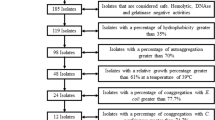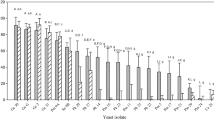Abstract
We studied here the yeast content of poultry feces, collected randomly from a French farm located in the north of the country. Thus, 81 yeast colonies were isolated and clustered into 22 distinct groups using the rep-PCR method. A single colony was taken from each group and identified using biochemical (ID 32C system) and molecular (sequencing of the D1/D2 domain of 26S rDNA and ITS1-5.8-ITS2 rDNA region) methods. Both methods led to the identification of Candida famata species. One isolate of C. famata strains, named strain Y5, was further studied for its cytotoxicity, adhesion, and surface properties, hemolytic activity, and its survival in simulated gastric and intestine environments. The data obtained advocate the probiotic potential of this isolate.



Similar content being viewed by others
References
Anadón A, Larrañaga RMM, Martínez AM (2006) Probiotics for animal nutrition in the European union, regulation and safety assessment. Regul Toxicol Pharmacol 45:91–95
Tellez G, Pixley C, Wolfenden RE, Layton SL, Hargis BM (2012) Probiotics/direct fed microbials for Salmonella control in poultry. Food Res Int 45:628–633
Haddad N, Burns CM, Bolla JM, Prévost H, Fédérighi M, Drider D, Cappelier JM (2009) Long-term survival of Campylobacter jejuni at low temperatures is dependent on polynucleotide phosphorylase activity. Appl Environ Microbiol 75:7310–7318
Apajalahti J, Kettunen A, Graham H (2004) Characteristics of the gastrointestinal microbial communities, with special reference to the chicken. World Poult Sci J 60:223–232
Chambers JR, Gong J (2011) The intestinal microbiota and its modulation for Salmonella control in chickens. Food Res Int 44:3149–3159
Cisek AA, Binek M (2014) Chicken intestinal microbiota function with a special emphasis on the role of probiotic bacteria. Pol J Vet Sci 17:385–394
Jozefiak D, Rutkowski A, Kaczmarek S, Jensen BB, Engberg RM, Højberg O (2010) Effect of β-glucanase and xylanase supplementation of barley- and rye-based diets on caecal microbiota of broiler chickens. Br Poult Sci 51:546–557
Singh KM, Shah TM, Reddy B, Deshpande S, Rank DN, Joshi CG (2014) Taxonomic and gene-centric metagenomics of the fecal microbiome of low and high feed conversion ratio (FCR) broilers. J Appl Genet 55:145–154
Banjeree P, Pradhan NR (2006) Live yeasts a good alternative to AGP in broiler chickens. World Poult 22:32–34
Higgins SE, Erf GF, Higgins JP, Henderson SN, Wolfenden AD, Gaona-Ramirez G, Hargis BM (2007) Effect of probiotic treatment in broiler chicks on intestinal macrophage numbers and phagocytosis of Salmonella enteritidis by abdominal exudate cells. Poult Sci 86:2315–2321
Higgins SE, Higgins JP, Wolfenden AD, Henderson SN, Torres-Rodriguez A, Tellez G, Hargis B (2008) Evaluation of a Lactobacillus-based probiotic culture for the reduction of Salmonella enteritidis in neonatal broiler chicks. Poult Sci 87:27–31
La Ragione RM, Woodward MJ (2003) Competitive exclusion by Bacillus subtilis spores of Salmonella enterica serotype enteritidis and Clostridium perfringens in young chickens. Vet Microbiol 94:245–256
La Ragione RM, Narbad A, Gasson MJ, Woodward MJ (2004) In vivo characterization of Lactobacillus johnsonii FI9785 for use as a defined competitive exclusion agent against bacterial pathogens in poultry. Lett Appl Microbiol 38:197–205
Harju S, Fedosyuk H, Peterson KR (2004) Rapid isolation of yeast genomic DNA: Bust n’ Grab. BMC Biotechnol 4:8–13
Ouoba LII, Kando C, Parkouda C, Sawadogo-Lingani H, Diawara B, Sutherland JP (2012) The microbiology of Bandji, palm wine of Borassus akeassii from Burkina Faso: identification and genotypic diversity of yeasts, lactic acid and acetic acid bacteria. J Appl Microbiol 113:1428–1441
Ouoba LII, Nyanga-Koumou CAG, Parkouda C, Sawadogo H, Kobawila SC, Keleke S, Diawara B, Louembe D, Sutherland JP (2010) Genotypic diversity of lactic acid bacteria isolated from African traditional alkaline-fermented foods. J Appl Microbiol 108:2019–2029
Al Kassaa I, Hamze M, Hober D, Chihib NE, Drider D (2014) Identification of vaginal lactobacilli with potential probiotic properties isolated from women in North Lebanon. Microbial Ecol 67:722–734
Cocolin L, Bisson LF, Mills DA (2000) Direct profiling of the yeast dynamics in wine fermentations. FEMS Microbiol Lett 189:81–87
Cocolin L, Aggio D, Manzano M, Cantoni C, Comi G (2002) An application of PCR-DGGE analysis to profile the yeast populations in raw milk. Int Dairy J 12:407–411
Belloch C, Barrio E, Garcia MD, Querol A (1998) Phylogenetic reconstruction of the yeast genus Kluyveromyces: restriction map analysis of the 5.8S rRNA gene and the two ribosomal internal transcribed spacer. Syst Appl Micriobiol 21:266–273
Schoch CL, Seifert KA, Huhndorf S, Robert V, Spouge JL, Levesque CA, Chen W (2012) Nuclear ribosomal internal transcribed spacer (ITS) region as a universal DNA barcode marker for Fungi. Proc Natl Acad Sci USA 109:6241–6246
Cole JR, Wang Q, Fish JA, Chai B, McGarrell DM, Sun Y, Brown CT, Porras-Alfaro A, Kuske CR, Tiedje JM (2014) Ribosomal Database Project: data and tools for high throughput rRNA analysis. Nucleic Acids Res 42:D633–D642
Rosenberg M, Gutnick D, Rosenberg E (1980) Adherence of bacteria to hydrocarbons: a simple method for measuring cell-surface hydrophobicity. FEMS Microbiol Lett 9:29–33
Charteris WP, Kelly PM, Morelli L, Collins JK (1998) Development and application of an in vitro methodology to determine the transit tolerance of potentially probiotic Lactobacillus and Bifidobacterium species in the upper human gastrointestinal tract. J Appl Microbiol 84:759–768
Williamson KJ, Johnson DG (1981) A bacterial bioassay for assessment of wastewater toxicity. Water Res 15:383–390
Oakley BB, Lillehoj HS, Kogut MH, Kim WK, Maurer JJ, Pedroso A, Lee MD, Collett SR, Johnson TJ, Cox NA (2014) The chicken gastrointestinal microbiome. FEMS Microbiol Lett 360:100–112
Yeoman CJ, Chia N, Jeraldo P, Sipos M, Goldenfeld ND, White BA (2012) The microbiome of the chicken gastrointestinal tract. Anim Health Res Rev 13:89–99
Newell DG, Elvers KT, Dopfer D, Hansson I, Jones P, James S, Gittins J, Stern NJ, Davies R, Connerton I, Pearson D, Salvat G, Allen VM (2011) Biosecurity-based interventions and strategies to reduce Campylobacter spp. on poultry farms. Appl Environ Microbiol 77:8605–8614
García-Hernández Y, Rodríguez Z, Brandão LR, Rosa CA, Nicoli JR, Iglesias AE, Peréz-Sanchez T, Salabarría RB, Halaihel N (2012) Identification and in vitro screening of avian yeasts for use as probiotic. Res Vet Sci 93:798–802
Dmytruk KV, Sibirny AA (2012) Candida famata (Candida flareri). Yeast 29:453–458
Beyda ND, Chuang SH, Alam MJ, Shah DN, Ng TM, McCaskey L, Garey KW (2013) Treatment of Candida famata bloodstream infections: case series and review of the literature. J Antimicrob Chemother 68:438–443
Castanheira M, Woosley LN, Diekema DJ, Jones RN, Pfaller MA (2013) Candida guilliermondii and other species of Candida misidentified as Candida famata: assessment by vitek 2, DNA sequencing analysis, and matrix-assisted laser desorption ionization-time of flight mass spectrometry in two global antifungal surveillance programs. J Clin Microbiol 51:117–124
Hatoum R, Labrie S, Fliss I (2012) Antimicrobial and probiotic properties of yeasts: from fundamental to novel applications. Front Microbiol 19(3):421
Drider D, Rebuffat S (2011) Prokaryotic antimicrobial peptides: from genes to applications. Springer Science & Business Media, NY
Rossoni RD, Barbosa JO, Vilela SF, Jorge AO, Junqueira JC (2013) Comparison of the hemolytic activity between C. albicans and non-albicans Candida species. Braz Oral Res 27:484–489
Souza RC, Junqueira JC, Rossoni RD, Pereira CA, Munin E, Jorge AO (2010) Comparison of the photodynamic fungicidal efficacy of methylene blue, toluidine blue, malachite green and low-power laser irradiation alone against Candida albicans. Lasers Med Sci 25:385–389
Emira N, Mejdi S, Dorra K, Amina B, Eulogio V (2011) Comparison of the adhesion ability of Candida albicans strains to biotic and abiotic surfaces. Afr J Biotechnol 10:977–985
Pacheco M, Pisa D, García-Gómez P, Carrasco L, Juarranz A (2007) Attachment and entry of Candida famata in monocytes and epithelial cells. Microsc Res Tech 70:975–986
Acknowledgments
Alaa Al Seriah was a recipient of PhD scholarship awarded from Iraqi and French governments, managed by Campus France. Research at Charles Viollette Institute was supported by Industrial research program funded by Best Environmental Technologies (Alberta, Canada). We are indebted to Mickaël Chevalier for his technical assistance in MALDI-TOF MS analysis.
Author information
Authors and Affiliations
Corresponding author
Ethics declarations
Conflict of interest
Alaa Al-Seraih, Christophe Flahaut, François Krier, Benoit Cudennec and Djamel Drider declare that they have no conflict of interest.
Rights and permissions
About this article
Cite this article
Al-Seraih, A., Flahaut, C., Krier, F. et al. Characterization of Candida famata Isolated from Poultry Feces for Possible Probiotic Applications. Probiotics & Antimicro. Prot. 7, 233–241 (2015). https://doi.org/10.1007/s12602-015-9201-y
Published:
Issue Date:
DOI: https://doi.org/10.1007/s12602-015-9201-y




